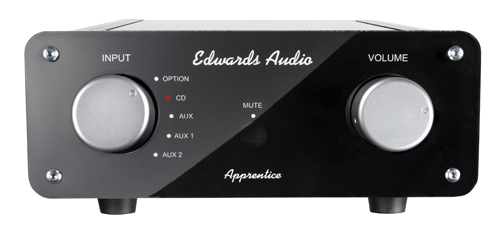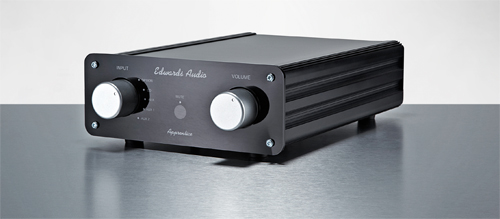What Hi-Fi? Verdict
This is a bold effort but the IA1 lacks the performance and finesse to truly impress
Pros
- +
Compact size
- +
Decent detail and bite
- +
Clear and clean sound
Cons
- -
Could do with more subtlety
- -
Build could be better
- -
Retains a brash edge
- -
Pricey
Why you can trust What Hi-Fi?
Like Cyrus, the Edwards Audio IA1 integrated amplifier is housed in a half-width shell. The IA1 is part of the company's Apprentice series, and at £400 it's pricey compared to some rivals.
Edwards Audio IA1 review: Design
The space-saving size means there's room for only one set of speaker terminals on the rear panel, with connections extending to four RCA line-level inputs, along with a 3.5mm input, and the option for a moving-magnet phono stage and digital inputs.
There's no remote control included with this model (the IA1-R is the version you want for that) so you'll have to change the inputs and volumes manually.
This is the IA1's first hiccup, as the rotary controls feel a bit wobbly and loose to the touch. Compared to some rivals, the overall build quality of the IA1 falls short, especially given its £400 billing.
Edwards Audio IA1 review: Performance
On to audio matters, and the Edwards Audio delivers a clean and direct sound, all of 50W powering through each channel. It's a bright and harsh sound straight out of the box, so we'd strongly suggest letting it run in for at least a night or two to calm down that sharp and aggressive top end.

Spin the CD soundtrack of Ocean's Eleven and the orchestral arrangement of Quincy Jones's Blues in the Night and the recordings are faithfully conveyed with sharply edged, well-separated instruments, albeit in a rather small and cramped soundstage.
The IA1 does favour the mid-to-top end of the frequency range, a quality which can exaggerate the lingering shimmer of brightness. Careful partnering with speakers and source is a must with this amp. The midrange bias would complement vocal-heavy songs nicely, and it does so – but only up to a point.
The brash sound of the IA1 does well with driving forward Amanda Palmer's aggressive vocals. However, play Norah Jones's debut hit Come Away With Me, and her smooth and jazzy vocals are scrubbed clean – but to the point that the relaxed and mellow dynamics of her voice aren't fully conveyed. Any emotional connection to the lyrics of her song is lost – even the piano notes plonk ahead with little hint of subtlety or elegance.
The Denon PMA-720AE, for example, is similarly forward in its presentation, but in that instance the amp has great timing on its side to charge rather more confidently through more demanding pieces. Not so with the IA1 – switch gears to any Radiohead track, and it's clear the amp doesn't have the precisely honed timing capabilities of its rivals.
Edwards Audio IA1 review: Verdict
All in all, this is not an unpleasant listen at all, clean and clear sound being a high point of the amplifier's capabilities. But with its unsubtle dynamics, brash edge and lack of outright refinement and detail, the IA1 fails to stand out from the crowd.
What Hi-Fi?, founded in 1976, is the world's leading independent guide to buying and owning hi-fi and home entertainment products. Our comprehensive tests help you buy the very best for your money, with our advice sections giving you step-by-step information on how to get even more from your music and movies. Everything is tested by our dedicated team of in-house reviewers in our custom-built test rooms in London, Reading and Bath. Our coveted five-star rating and Awards are recognised all over the world as the ultimate seal of approval, so you can buy with absolute confidence.


